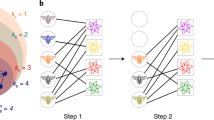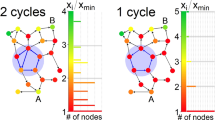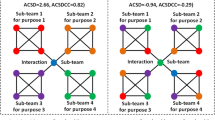Abstract
Catastrophic and major disasters in real-world systems ranging from financial markets and ecosystems, often show generic early-warning signals that may indicate a collapse. Hence, understanding the collapse mechanism of a complex network and predicting its process are of uttermost importance. However, these challenges are often hindered by the extremely high dimensionality of the underlying system. We present here the concept of the fractional core (F-core) that considers the contribution of the network topology and dynamics to systematically analyze the collapse process in such networks, and encompass a broad range of dynamical systems, from mutualistic ecosystems to regulatory dynamics. We offer testable predictions on the tipping point, and, in particular, prove that the extinction of the maximum F-core of a network is an efficient indicator of whether a system completely collapses. The results show that the death of species or cells in a low-order F-core may improve the average density and have little influence on the tipping point. Generally, the principle of the F-core demonstrates how complex systems collapse and opens an innovative optimization strategy to uncover the optimal structure of systems.
Similar content being viewed by others
References
Yeakel J D, Pires M M, Rudolf L, et al. Collapse of an ecological network in Ancient Egypt. Proc Natl Acad Sci USA, 2014, 111: 14472–14477
Lenton T M, Held H, Kriegler E, et al. Tipping elements in the Earth’s climate system. Proc Natl Acad Sci USA, 2008, 105: 1786–1793
Mehrabi Z. Food system collapse. Nat Clim Chang, 2020, 10: 16–17
Gao J, Barzel B, Barabási A L. Universal resilience patterns in complex networks. Nature, 2016, 530: 307–312
Arani B M S, Carpenter S R, Lahti L, et al. Exit time as a measure of ecological resilience. Science, 2021, 372: eaay4895
Pettersson S, Savage V M, Jacobi M N. Predicting collapse of complex ecological systems: quantifying the stability-complexity continuum. J R Soc Interface, 2020, 17: 20190391
Scheffer M, Carpenter S R, Lenton T M, et al. Anticipating critical transitions. Science, 2012, 338: 344–348
Thompson J N. Mutualistic webs of species. Science, 2006, 312: 372–373
Albrecht J, Berens D G, Jaroszewicz B, et al. Correlated loss of ecosystem services in coupled mutualistic networks. Nat Commun, 2014, 5: 3810
Scheffer M, Carpenter S, Foley J A, et al. Catastrophic shifts in ecosystems. Nature, 2001, 413: 591–596
Kéfi S, Rietkerk M, Alados C L, et al. Spatial vegetation patterns and imminent desertification in Mediterranean arid ecosystems. Nature, 2007, 449: 213–217
Drake J M, Griffen B D. Early warning signals of extinction in deteriorating environments. Nature, 2010, 467: 456–459
Dai L, Vorselen D, Korolev K S, et al. Generic indicators for loss of resilience before a tipping point leading to population collapse. Science, 2012, 336: 1175–1177
Lever J J, van Nes E H, Scheffer M, et al. The sudden collapse of pollinator communities. Ecol Lett, 2014, 17: 350–359
Carpenter S R, Brock W A. Rising variance: a leading indicator of ecological transition. Ecol Lett, 2006, 9: 311–318
Guttal V, Jayaprakash C. Changing skewness: an early warning signal of regime shifts in ecosystems. Ecol Lett, 2008, 11: 450–460
Carpenter S R, Brock W A, Cole J J, et al. Leading indicators of trophic cascades. Ecol Lett, 2008, 11: 128–138
Scheffer M, Bascompte J, Brock W A, et al. Early-warning signals for critical transitions. Nature, 2009, 461: 53–59
Simpson-Porco J W, Dörfler F, Bullo F. Voltage collapse in complex power grids. Nat Commun, 2016, 7: 10790
Obura D, Gudka M, Samoilys M, et al. Vulnerability to collapse of coral reef ecosystems in the Western Indian Ocean. Nat Sustain, 2022, 5: 104–113
Morone F, Ferraro G D, Makse H A. The k-core as a predictor of structural collapse in mutualistic ecosystems. Nat Phys, 2019, 15: 95–102
Zhang F, Xie J, Wang K, et al. Discovering key users for defending network structural stability. World Wide Web, 2022, 25: 679–701
Burleson-Lesser K, Morone F, Tomassone M S, et al. K-core robustness in ecological and financial networks. Sci Rep, 2020, 10: 1–4
May R M. Thresholds and breakpoints in ecosystems with a multiplicity of stable states. Nature, 1977, 269: 471–477
Mumby P J, Hastings A, Edwards H J. Thresholds and the resilience of Caribbean coral reefs. Nature, 2007, 450: 98–101
Xiong W, Ferrell J J E. A positive-feedback-based bistable ‘memory module’ that governs a cell fate decision. Nature, 2003, 426: 460–465
Gardner T S, Cantor C R, Collins J J. Construction of a genetic toggle switch in Escherichia coli. Nature, 2000, 403: 339–342
Moore J C. Predicting tipping points in complex environmental systems. Proc Natl Acad Sci USA, 2018, 115: 635–636
Laurence E, Doyon N, Dubé L J, et al. Spectral dimension reduction of complex dynamical networks. Phys Rev X, 2019, 9: 011042
Jiang J, Huang Z G, Seager T P, et al. Predicting tipping points in mutualistic networks through dimension reduction. Proc Natl Acad Sci USA, 2018, 115: 639–647
Barrat A, Barthélemy M, Pastor-Satorras R, et al. The architecture of complex weighted networks. Proc Natl Acad Sci USA, 2004, 101: 3747–3752
Revilla T A, Encinas-Viso F, Loreau M. Robustness of mutualistic networks under phenological change and habitat destruction. Oikos, 2015, 124: 22–32
Rodríguez-Rodríguez M C, Jordano P, Valido A. Functional consequences of plant-animal interactions along the mutualism-antagonism gradient. Ecology, 2017, 98: 1266–1276
Clauset A, Shalizi C R, Newman M E J. Power-law distributions in empirical data. SIAM Rev, 2009, 51: 661–703
Bellwood D R, Hughes T P, Folke C, et al. Confronting the coral reef crisis. Nature, 2004, 429: 827–833
Hughes T P, Graham N A J, Jackson J B C, et al. Rising to the challenge of sustaining coral reef resilience. Trends Ecol Evol, 2010, 25: 633–642
Perry C T, Alvarez-Filip L, Graham N A J, et al. Loss of coral reef growth capacity to track future increases in sea level. Nature, 2018, 558: 396–400
Ollerton J, McCollin D, Fautin D G, et al. Finding NEMO: nestedness engendered by mutualistic organization in anemonefish and their hosts. Proc R Soc B, 2007, 274: 591–598
Balaji S, Babu M M, Iyer L M, et al. Comprehensive analysis of combinatorial regulation using the transcriptional regulatory network of yeast. J Mol Biol, 2006, 360: 213–227
Urban M C. Accelerating extinction risk from climate change. Science, 2015, 348: 571–573
Cardinale B J, Matulich K L, Hooper D U, et al. The functional role of producer diversity in ecosystems. Am J Bot, 2011, 98: 572–592
Fetzer I, Johst K, Schäwe R, et al. The extent of functional redundancy changes as species’ roles shift in different environments. Proc Natl Acad Sci USA, 2015, 112: 14888–14893
Isbell F, Craven D, Connolly J, et al. Biodiversity increases the resistance of ecosystem productivity to climate extremes. Nature, 2015, 526: 574–577
Mills L S, Soulé M E, Doak D F. The Keystone-species concept in ecology and conservation. BioScience, 1993, 43: 219–224
Peers M J L, Majchrzak Y N, Menzies A K, et al. Climate change increases predation risk for a keystone species of the boreal forest. Nat Clim Chang, 2020, 10: 1149–1153
Kikuchi Y, Tada A, Musolin D L, et al. Collapse of insect gut symbiosis under simulated climate change. mBio, 2016, 7: e01578–16
Lobanova G, Fath B D, Rovenskaya E. Exploring simple structural configurations for optimal network mutualism. Commun Nonlinear Sci Numer Simul, 2009, 14: 1461–1485
Angelini C, Griffin J N, van de Koppel J, et al. A keystone mutualism underpins resilience of a coastal ecosystem to drought. Nat Commun, 2016, 7: 1–8
Acknowledgements
This work was supported in part by National Natural Science Foundation of China (Grant Nos. 72171193, 72231008, 72071153), Key Research and Development Program of Shaanxi Province (Grant No. 2022KW-15), and Natural Science Foundation of Shaanxi Province (Grant No. 2023-JC-QN-0802).
Author information
Authors and Affiliations
Corresponding authors
Additional information
Supporting information
Appendixes A and B. The Appendix includes experimental setup and results. The supporting information is available online at info.scichina.com and link.springer.com. The supporting materials are published as submitted, without typesetting or editing. The responsibility for scientific accuracy and content remains entirely with the authors.
Electronic supplementary material
Rights and permissions
About this article
Cite this article
Si, S., Lv, C., Cai, Z. et al. Fractional core-based collapse mechanism and structural optimization in complex systems. Sci. China Inf. Sci. 66, 192202 (2023). https://doi.org/10.1007/s11432-022-3731-x
Received:
Revised:
Accepted:
Published:
DOI: https://doi.org/10.1007/s11432-022-3731-x




